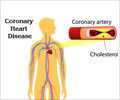The presence of a particular gene may predict the hardening of arteries which could lead to a heart attack, according to recent research.
The presence of a particular gene may predict the hardening of arteries which could lead to a heart attack, according to recent research by an Indian-origin researcher at Duke University Medical School in North Carolina.
Millions of people under 40 across worldwide suffer without knowing from early coronary artery disease, which in many cases leads to heart attacks in later life.Now, Svati Shah, co-author of the study along with colleagues believe they have pinpointed a gene or marker that can help predict in advance whether someone is at increased risk.
They believe that this could lead to a test to identify the latent threat of hardened arteries so that patients could be given dietary advice and other treatment before too much damage is done.
"These young patients are a vulnerable population on whom coronary artery disease has a significant long-term impact, but they are particularly hard to identify and therefore to initiate preventive therapies for," the Telegraph quoted Shah, as saying.
"These and other genetic findings may help us in the future to identify these patients prior to development of coronary artery disease or their first heart attack," the expert added.
Known as neuropeptide Y (NPY), it is one of the most plentiful and important proteins in the body and is linked to the control of appetite and feeding behaviour, among other things.
Advertisement
To reach the conclusion, the scientists evaluated 1,000 families for coronary artery disease or evidence of a true heart attack, as part of a larger study put together by Duke University.
Advertisement
"If you had 1 or 2 copies of this mutant version of the gene, there could be a change in NPY level. The concept is that small changes over time can promote atherosclerosis (hardening of the arteries) at a very young age," Shah said.
Experiments on mice subsequently confirmed that the NPY promotes atherosclerosis, according to the report published in the Public Library of Science journal.
Source-ANI
SAV














